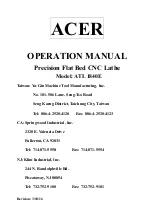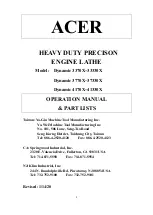
7. TROUBLEShOOTING
6. mAINTENANCE
pROBLEm
pOSSIBLE CAUSE
SOLUTION
Motor will not run
Defective On/Off switch or
Replace defective parts.
defective switch cable
Motor burnt out
DO NOT attempt to repair. Contact your local
authorised service agent.
Lathe slows down when turning
Tools blunt
Sharpen tools.
Cut too deep
Reduce cut
Headstock or tailstock loose on bed
Insufficient clamping
Tighten large nut beneath head/tailstock to
increase clamping (adjust nut with clamping
lever ‘Off’).
Workpiece chars at tailstock end
Cup centre too tight or not lubricated
Back off tailstock spindle and lubricate cup centre.
WARNING! Ensure the lathe is unplugged from the mains power supply before service or maintenance.
6.1
Keep the lathe clean and the surrounding area tidy.
6.2
Frequently blow out any dust accumulation in the motor, housing and bed.
Wear eye protection when doing so.
6.3
Protect the bed from corrosion by occasionally applying automobile wax.
6.4
Regularly lightly oil control and clamp levers and threads to ensure smooth operation.
Should the motor require service or maintenance contact your local authorised service agent.
5. USING ThE LAThE
WARNING! Ensure you read, understand and apply the safety instructions before using the lathe.
If you have NO turning experience, we recommend you practice until you have familiarised yourself with the applications and
limitations of the lathe and the hazards of turning.
dO NOT TAKE ANY ChANCES WhEN WORKING WITh A LAThE ANd TURNING TOOLS.
Keep alert. dO NOT allow familiarity (from frequent use) to cause a careless mistake. Remember, failure to operate the lathe
correctly is dangerous and may cause serious damage and/or personal injury.
5.1.
Fasten the workpiece securely to the faceplate or between centres. When screwing a workpiece to the faceplate use brass wood
screws and check that the points of the screws will not foul the tool during turning.
5.2.
Adjust the tool rest to suit, ensuring that it is close to the workpiece and, for spindle turning, positioned above the centre line of the
workpiece.
5.3.
To confirm that the workpiece will not hit any part of the lathe always rotate it by hand before turning on the motor.
5.4.
Check that all clamps and locks are tightened before switching on the lathe.
5.5.
Rough out “out-of-round” workpieces at a slow speed. Running the lathe too fast will cause vibration, which may result in the
workpiece being thrown from the lathe, or the tool being pulled from your hand.
5.6.
Keep a firm control of the cutting tool. Care must be exercised when wood knots or voids in the workpiece are exposed.
5.7.
Complete any hand sanding before removing the workpiece from the lathe. Ensure that the lathe speed during sanding does not
exceed the last cutting speed used.
noTE:
It is our policy to continually improve products and as such we reserve the right to alter data, specifications and component parts without prior notice.
ImpORTANT:
No liability is accepted for incorrect use of this product.
WARRANTY:
Guarantee is 12 months from purchase date, proof of which will be required for any claim.
INFORmATION:
For a copy of our latest catalogue and promotions call us on 01284 757525 and leave your full name and address, including postcode.
01284 757500
01284 703534
Sole UK distributor, Sealey Group,
Kempson Way, Suffolk Business Park
,
Bury St. Edmunds, Suffolk,
IP32 7AR
www.sealey.co.uk
Web
Original Language Version
SM1100.V2 Issue: 3 - 23/03/10






















